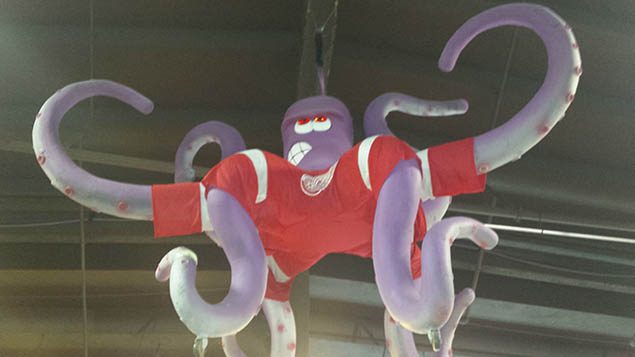This Day in Hockey History – April 15, 1952 – Octopi in the Sky
(Photo: Doug Kerr from Albany, NY, United States [CC BY-SA 2.0] )
Nowadays, throwing anything on the ice is frowned upon. That does not stop fans from following one particular tradition that has been attached to the Detroit Red Wings since April 15, 1952, when the first octopus was thrown onto their ice.
Back in 1952, teams had to play two best-of-seven series in order to win the Stanley Cup. That meant that the fewest amount of games needed to win was eight while the most was fourteen. When the Red Wings had last won the championship, in 1950, they had to play all fourteen to squeeze out a win. The 1951-52 postseason looked like it would end much sooner.
Detroit had finished first in the NHL with 100 points (44-14-12) and had the league’s top two scorers, Gordie Howe (86P) and Ted Lindsay (69P). They swept the Toronto Maple Leafs in four games during the semi-finals. Beginning the series at Detroit, Terry Sawchuk shutout the visitors in the first two contests, 3-0 and 1-0. In the latter two tilts up in Toronto, the Red Wings scored a total of nine goals to the Leafs’ three.
After a nine-day break, the Wings traveled up to Montreal for the finals. There, Detroit defeated the Canadiens 3-1 and 2-1. The play moved to Detroit for Game 3 on April 13, when Sawchuk earned his third shutout of the playoffs. The Red Wings were leading the series 3-0 and had only played seven playoff games.
At about this time, a conversation was held at Detroit’s Eastern Market by its owners, brothers Pete and Jerry Cusimano. According to Pete, Jerry picked up an octopus tentacle and said, “Here’s the thing with eight legs. Why don’t we throw it on the ice and maybe the Wings’ll win eight straight?” The brothers thought the eight-legged mollusk neatly represented the eight wins necessary to take home the Stanley Cup.
For Game 4 on April 15, the Olympia held a crowd of 14,545, including the Cusimano brothers. Almost seven minutes into the first period, Detroit’s Metro Prystai scored the first goal of the night. With the score remaining unchanged midway through the game, the Cusimano brothers made their move. The Montreal Gazette made two brief mentions of the incident. “Some hardy soul, apparently from a line of deep sea fishermen, tossed a small octopus on the ice. Referee Bill Chadwick halted play to dispose of the little crawler.” Later in the article, the Gazette noted that “fans got a great laugh when a fan threw a dead octopus 10 inches long on the ice. Play was halted for a minute.” That seemed to be that. Later that period, Glen Skov scored another Detroit goal. Finally, at 7:35 of the third, Prystai scored again for the Red Wings.
Once again, Sawchuk had stopped all comers. He told the press afterwards, “This last game was the toughest of the entire series, and I believe it was my best game. The Canadiens were trying to rough me up in the goal mouth and knock me off my feet every time they skated by.” That did not seem to matter considering he had finished the playoffs with four shutouts, all on home ice. That tied him with Toronto’s Frank McColl and New York’s Dave Kerr for the record in playoff shutouts.
As the Cusimano brothers had hoped, the Red Wings had swept the entire playoffs in eight games. They were the first to do so since the 1939 implementation of the best-of-seven series. On receiving the Stanley Cup, captain Syd Abel said to President Clarence Campbell, “Thanks for the return of the Stanley Cup. Now it’s back in Detroit, where it belongs.” Detroit Coach Jack Adams called this “the best balanced team I’ve seen in my 35 years in hockey as a player, coach and manager.” To encourage more season endings like 1952, the “Legend of the Octopus” tradition of throwing octopi on the ice has continued, even as the victories needed to win doubled. They rained down on the ice when Detroit’s Joe Louis Arena opened in 1979 and closed in 2017. During the octopus heyday, at one game in 1995, the ice was scattered with a total of 36 octopuses with some weighing over 30 pounds. The head ice manager and Zamboni driver, Al Sobotka, had the task of clearing the ice and would make a show of swinging the dead cephalopods over his head. In April 2008, the NHL tried to ban this (to prevent how “matter flies off the octopus and gets on the ice”) by giving the linesmen clean-up duty instead. They faced backlash in what the Detroit Free Press called “Octopus-gate,” so by playoffs the ban had loosened. Named for Sobotka, Al the Octopus is Detroit’s mascot, who is raised to the rafters wearing a No. 8 jersey.
Additional Sources:
- Mike Commito, Hockey 365: Daily Stories from the Ice (Toronto: Dundurn, 2018), kindle edition.
- Vern Degeer, “Defeat Canadiens 3-0; Sweep Playoff Series,” Montreal Gazette, 16 April 1952, p. 18.
- “Wings Complete Cup Sweep,” Detroit Free Press, 16 April 1952, pp. 1 and 19.
- Brian McFarlane, Brian McFarlane’s History of Hockey (Champaign, Ill.: Sports Publishing Inc., c1997), 70-71.














